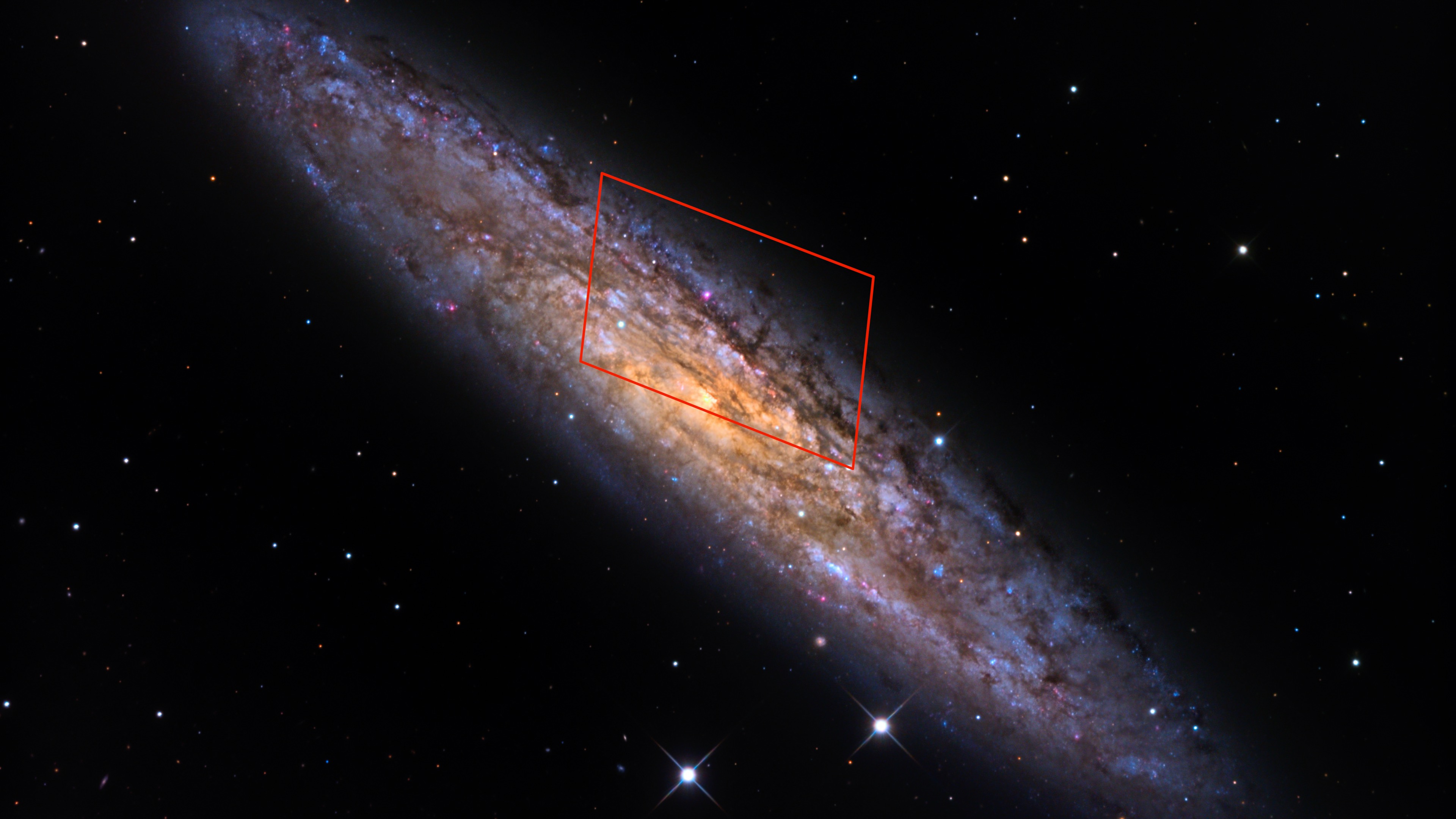A brief burst of high-energy light swept through the solar system on April 15, 2020, triggering many space-based instruments, including those aboard NASA and European missions. Now, multiple international science teams, including a team of researchers at the George Washington University, conclude that the blast came from a supermagnetized stellar remnant known as a magnetar located in a neighboring galaxy.
This finding confirms long-held suspicions that some gamma-ray bursts (GRBs)–cosmic eruptions detected in the sky almost daily–are in fact powerful flares from magnetars relatively close to home.
“This has always been regarded as a possibility, and several GRBs observed since 2005 have provided tantalizing evidence,” said Kevin Hurley, a senior space fellow with the Space Sciences Laboratory at the University of California, Berkeley, who joined several scientists to discuss the burst at the virtual 237th meeting of the American Astronomical Society. “The April 15 event is a game changer because we found that the burst almost certainly lies within the disk of the nearby galaxy NGC 253.”
Papers analyzing different aspects of the event and its implications were published on Jan. 13 in the journals Nature and Nature Astronomy. A team of magnetar experts from GW’s Columbian College of Arts and Sciences was involved in the data analyses and interpretation of the event.
“Although we did expect at least 10 percent of short gamma ray bursts to consist of camouflaged magnetar giant flares, it was always very tough to unambiguously confirm such candidates in the past,” said Chryssa Kouveliotou, a professor of physics at GW and co-author on one of the papers (“Rapid spectral variability of a giant flare from a magnetar in NGC 253”). Dr. Kouveliotou coordinated the GW research team and worked closely with a team from NASA’s Marshall Space Flight Center to interpret the data.
George Younes, a research professor in physics at GW, performed part of the spectral analysis of data collected from an instrument aboard NASA’s Fermi Gamma-ray Space Telescope, while Sylvain Guiriec, an assistant professor of physics at GW, also performed detailed spectral analysis of the event.
"The temporal and spectral properties of this gamma-ray explosion were very unusual for a short gamma ray burst,” Dr. Guiriec said. “These results supported the hypothesis of a powerful flare from a magnetar in a nearby galaxy.”
Alexander van der Horst, an associate professor of physics at GW, and his graduate student, Sarah Chastain, acquired and analyzed radio data observations from the Karl G. Jansky Very Large Array in New Mexico. Finding a radio counterpart to the X-rays and gamma rays detected by space-based instruments would have helped pinpoint where in the galaxy the source resided and potentially provide additional information about its environment and the outflow from the magnetar associated with the blast.
“The galaxy was clearly detected, but there was no radio counterpart of the magnetar blast,” Ms. Chastain said.
GRBs, the most powerful explosions in the cosmos, can be detected across billions of light-years. Those lasting less than about two seconds, called short GRBs, occur when a pair of orbiting neutron stars–both the crushed remnants of exploded stars–spiral into each other and merge. Astronomers confirmed this scenario for at least some short GRBs in 2017, when a burst followed the arrival of gravitational waves–ripples in space-time–produced when neutron stars merged 130 million light-years away.
Magnetars are neutron stars with the strongest-known magnetic fields, with up to a thousand times the intensity of typical neutron stars and up to 10 trillion times the strength of a refrigerator magnet. Modest disturbances to the magnetic field can cause magnetars to erupt with sporadic X-ray bursts for weeks or longer.
Rarely, magnetars produce enormous eruptions called giant flares that produce gamma rays, the highest-energy form of light.

This illustration shows a close-up view of the April 15 magnetar giant flare. A magnetar is a city-sized ball containing more mass than the Sun and boasting the strongest magnetic fields known. A sudden reconfiguration of this field, possibly caused by a starquake, produced a quick, powerful pulse of X-rays and gamma rays (magenta). Scientists think the April 15 event also ejected a blob of matter moving at nearly the speed of light. Credit: NASA’s Goddard Space Flight Center/Chris Smith (USRA/GESTAR)
Most of the 29 magnetars now cataloged in our Milky Way galaxy exhibit occasional X-ray activity, but only two have produced giant flares. The most recent event, detected on Dec. 27, 2004, produced measurable changes in Earth’s upper atmosphere despite erupting from a magnetar located about 28,000 light-years away.
Shortly before 4:42 a.m. EDT on April 15, 2020, a brief, powerful burst of X-rays and gamma rays swept past Mars, triggering the Russian High Energy Neutron Detector aboard NASA’s Mars Odyssey spacecraft, which has been orbiting the planet since 2001. About 6.6 minutes later, the burst triggered the Russian Konus instrument aboard NASA’s Wind satellite, which orbits a point between Earth and the Sun located about 930,000 miles (1.5 million kilometers) away. After another 4.5 seconds, the radiation passed Earth, triggering instruments on NASA’s Fermi Gamma-ray Space Telescope, as well as on the European Space Agency’s INTEGRAL satellite and Atmosphere-Space Interactions Monitor (ASIM) aboard the International Space Station.
The eruption occurred beyond the field of view of the Burst Alert Telescope (BAT) on NASA’s Neil Gehrels Swift Observatory, so its onboard computer did not alert astronomers on the ground. Thanks to a new capability, called the Gamma-ray Urgent Archiver for Novel Opportunities (GUANO), the Swift team can beam back BAT data when other satellites trigger on a burst. Analysis of this data provided additional insight into the event.
The pulse of radiation lasted just 140 milliseconds–as fast as an eye blink or a finger snap.
The Fermi, Swift, Wind, Mars Odyssey and INTEGRAL missions all participate in a GRB-locating system called the InterPlanetary Network (IPN). Now funded by the Fermi project, the IPN has operated since the late 1970s using different spacecraft located throughout the solar system. Because the signal reached each detector at different times, any pair of them can help narrow down a burst’s location in the sky. The greater the distances between spacecraft, the better the technique’s precision.
The IPN placed the April 15 burst, called GRB 200415A, squarely in the central region of NGC 253, a bright spiral galaxy located about 11.4 million light-years away in the constellation Sculptor. This is the most precise sky position yet determined for a magnetar located beyond the Large Magellanic Cloud, a satellite of our galaxy and host to a giant flare in 1979, the first ever detected.

Giant flares from magnetars in or near the Milky Way evolve in a distinct way, with a quick rise to peak brightness followed by a rapidly fluctuating tail of emission. Observing this fluctuating tail is conclusive evidence of a giant flare. Seen from millions of light-years away, though, this tail emission is too dim to detect with today’s instruments, as seen in this illustration. Because these signatures are missing, giant flares in our galactic neighborhood can masquerade as much more distant and powerful merger-type GRBs. (Credit: NASA’s Goddard Space Flight Center)
Giant flares from magnetars in the Milky Way and its satellites evolve in a distinct way, with a rapid rise to peak brightness followed by a more gradual tail of fluctuating emission. These variations result from the magnetar’s rotation, which repeatedly brings the flare location in and out of view from Earth, much like a lighthouse.
Observing this fluctuating tail is conclusive evidence of a giant flare. Seen from millions of light-years away, though, this emission is too dim to detect with today’s instruments. Because these signatures are missing, giant flares in our galactic neighborhood may be masquerading as much more distant and powerful merger-type GRBs.
A detailed analysis of data from Fermi’s Gamma-ray Burst Monitor (GBM) and Swift’s BAT provides strong evidence that the April 15 event was unlike any burst associated with mergers, noted Oliver Roberts, an associate scientist at Universities Space Research Association’s Science and Technology Institute in Huntsville, Ala., who led the study.
In particular, this was the first giant flare known to occur since Fermi’s 2008 launch, and the GBM’s ability to resolve changes at microsecond timescales proved critical. The observations reveal multiple pulses, with the first one appearing in just 77 microseconds–about 13 times the speed of a camera flash and nearly 100 times faster than the rise of the fastest GRBs produced by mergers. The GBM also detected rapid variations in energy over the course of the flare that have never been observed before.
“Giant flares within our galaxy are so brilliant that they overwhelm our instruments, leaving them to hang onto their secrets,” Dr. Roberts said. “For the first time, GRB 200415A and distant flares like it allow our instruments to capture every feature and explore these powerful eruptions in unparalleled depth.”
Giant flares are poorly understood, but astronomers think they result from a sudden rearrangement of the magnetic field. One possibility is that the field high above the surface may become too twisted, suddenly releasing energy as it settles into a more stable configuration. Alternatively, a mechanical failure of the magnetar’s crust–a starquake–may trigger the sudden reconfiguration.
Dr. Roberts and his colleagues say the data show some evidence of seismic vibrations during the eruption. The highest-energy X-rays recorded by Fermi’s GBM reached 3 million electron volts (MeV), or about a million times the energy of blue light, itself a record for giant flares. The researchers say this emission arose from a cloud of ejected electrons and positrons moving at about 99% the speed of light. The short duration of the emission and its changing brightness and energy reflect the magnetar’s rotation, ramping up and down like the headlights of a car making a turn. Dr. Roberts describes it as starting off as an opaque blob–he pictures it as resembling a photon torpedo from the “Star Trek” franchise–that expands and diffuses as it travels.
The torpedo also factors into one of the event’s biggest surprises. The satellite’s main instrument, the Large Area Telescope (LAT), also detected three gamma rays, with energies of 480 MeV, 1.3 billion electron volts (GeV), and 1.7 GeV–the highest-energy light ever detected from a magnetar giant flare. What’s surprising is that all of these gamma rays appeared long after the flare had diminished in other instruments.
Nicola Omodei, a senior research scientist at Stanford University in California, led the LAT team investigating these gamma rays, which arrived between 19 seconds and 4.7 minutes after the main event. The scientists conclude that this signal most likely comes from the magnetar flare. “For the LAT to detect a random short GRB in the same region of the sky and at nearly the same time as the flare, we would have to wait, on average, at least 6 million years,” he explained.
A magnetar produces a steady outflow of fast-moving particles. As it moves through space, this outflow plows into, slows, and diverts interstellar gas. The gas piles up, becomes heated and compressed, and forms a type of shock wave called a bow shock.
In the model proposed by the LAT team, the flare’s initial pulse of gamma rays travels outward at the speed of light, followed by the cloud of ejected matter, which is moving nearly as fast. After several days, they both reach the bow shock. The gamma rays pass through. Seconds later, the cloud of particles – now expanded into a vast, thin shell – collides with accumulated gas at the bow shock. This interaction creates shock waves that accelerate particles, producing the highest-energy gamma rays after the main burst.
The April 15 flare proves that these events constitute their own class of GRBs. Eric Burns, an assistant professor of physics and astronomy at Louisiana State University in Baton Rouge, led a paper studying additional suspects using data from numerous missions. The findings will appear in The Astrophysical Journal Letters. Bursts near the galaxy M81 in 2005 and the Andromeda galaxy (M31) in 2007 had already been suggested to be giant flares, and the team identified a flare in M83, also seen in 2007 but newly reported. Add to these the giant flare from 1979 and those observed in our Milky Way in 1998 and 2004.
“It’s a small sample, but we now have a better idea of their true energies, and how far we can detect them,” Burns said. “A few percent of short GRBs may really be magnetar giant flares. In fact, they may be the most common high-energy outbursts we’ve detected so far beyond our galaxy–about five times more frequent than supernovae.”



